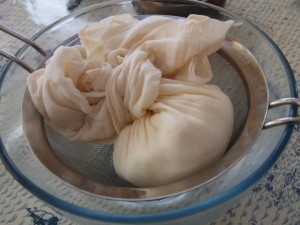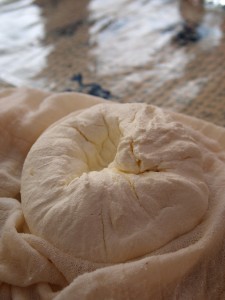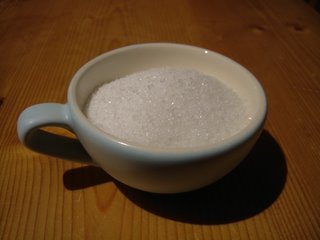
If you’re anything like me, you’ll be feeling somewhat bloated and liverish after Christmas and New Year, so I’ll hold the roast goose recipe back until later in the week when our gall bladders have all recovered. I was racking my brains for a nice easy recipe to start the year with – something that’s simple to prepare, and has few ingredients, but that tastes great and will impress guests or a picky family. How about labneh, a soft “cheese” from the middle east, made in your fridge from thick Greek-style yoghurt?
Greek yoghurt is thicker than the sloppy variety by virtue of having been strained until much of the whey drains out, leaving you with a richer, thicker product. Labneh takes the process further, continuing to drain until almost all of the whey has gone, and you are left with a thick, sharp-tasting ball that looks like soft cream cheese. It’s not a true cheese because rennet is not used in making it, but I like to use it where you might use something like Philadelphia – and when it’s made by the method below, with fresh garlic, you’ll find that it’s a mighty fine substitute for Boursin, richer, denser and without the dusty dried garlic taste you get in the packaged stuff from the supermarket. Labneh is a great addition to a cheeseboard, either in a chunk on its own or in a bowl, splashed with olive oil. Experiment by adding herbs to the garlic: for a Turkish flavour, try some dill and chillies; chop in some mint with the garlic for a Greek platter.
My Mum made the labneh in the pictures at Christmas as part of a cold supper. It’s fantastic wherever you’d use cream cheese or with crudites, and great crumbled over rich middle-eastern dishes, especially those containing lamb; I’ve got a cheesecloth full going in the fridge at the moment which is destined to be spread on crusty bread and served with a Greek-style lamb shoulder.
You’ll need:
400g Greek yoghurt (make sure that you choose a version without emulsifiers or thickeners; I like Total)
1 large pinch salt
2 cloves garlic, chopped as finely as possible

Line a sieve with a boiled cheesecloth, and put it over a bowl to catch drips. You can also use a boiled kitchen towel if you don’t have a cheesecloth – an old linen one which has been washed many times will be softer and easier to work with.
Stir the yoghurt, salt and garlic well in a bowl to make sure everything is well combined. You can leave the garlic out if you want a plain labneh; the garlic gives a lovely fiery kick to the finished cheese. Pour the yoghurt mixture into the lined sieve, bring the corners and edges up to form a bag around the labneh and twist together. You can secure the twist with string if you like, but it’s not really necessary.
Put the bowl and sieve into the fridge and leave the labneh to drain for between 24 and 48 hours, squeezing the bag every now and then. The cheese will be a pleasant, creamy texture after 24 hours, and leaving it for longer will make it even stiffer, and harder to spread.
To keep your labneh in the fridge, cover it completely with olive oil in a bowl. It will keep for two weeks, but I bet you won’t be able to stop yourself finishing it much sooner than that.



